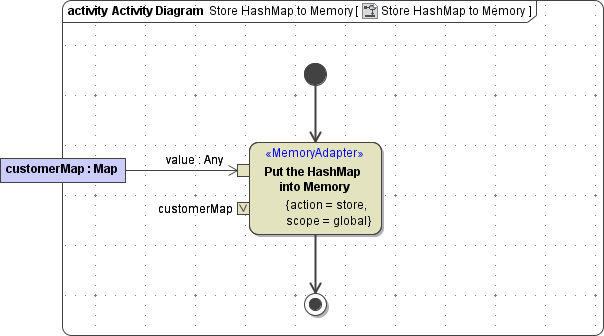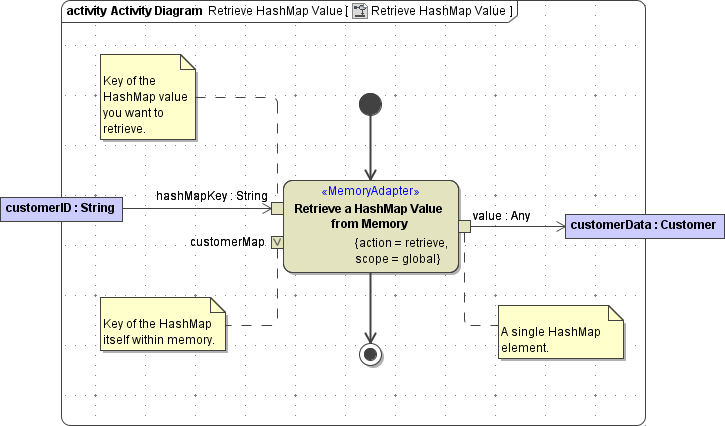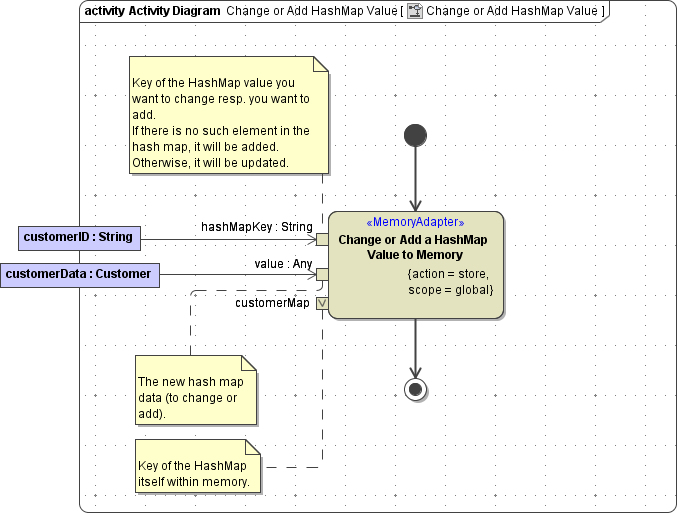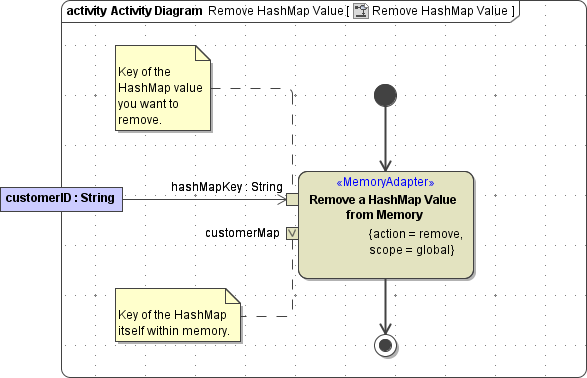Page History
Versions Compared
Key
- This line was added.
- This line was removed.
- Formatting was changed.
| Info |
|---|
This page explains the Memory Adapter in Bridge context. If you were looking for the same information regarding the PAS Designer, refer to Memory Adapter in the Designer guide. |
| Div | ||||||
|---|---|---|---|---|---|---|
| ||||||
|
...
| Multiexcerpt | ||||||||
|---|---|---|---|---|---|---|---|---|
| ||||||||
The Memory Adapter allows to store an entire hash map to memory. The hash map object as a whole can be managed with the Memory adapter the same way as any other objects. Additionally, the Memory adapter allows to add, change, retrieve, and remove elements from a stored hash map. Therefore, the Memory adapter provides an additional parameter hashMapKey. If this parameter is provided, the Memory adapter does not access the entire map, but tries to access the specified element of the map. This can significantly increase the performance, if you e.g. want to cache some data you frequently need to lookup, in comparison to caching this data in a database.
|
Storing a Map to Memory
To store a map to memory, provide the Memory adapter with the following:
- the complete map in parameter value
- a key, that can be used to access the map in memory
- the Memory Adapter action store
Figure: Storing a Complete Hash Map to memory
 Image Modified
Image Modified
The figure above illustrates how to store map customerMap (containing some customer data) to memory. The map is stored using key "customerMap".
If a map with the given key already exists in memory, it will be overwritten by the Memory Adapter. In this case, parameter oldValue returns the the complete previously stored hash map.
Retrieving Data from the Map
To retrieve an element from a map that has been stored to memory, provide the Memory adapter with the following:
- the key that has been used to store the map to memory ("customerMap" in the example below)
- the hashMapKey of the map element you want to retrieve
- the Memory Adapter action retrieve
Figure: Retrieving a Map Element from Memory
 Image Modified
Image Modified
A hash map containing some customer data has been stored to memory using the key "customerMap" (see Storing a Map to memory further above). Individual map elements from this map can be accessed via their key customerID.
The Memory adapter returns a single map element containing the customer data.
If there is no map element with the given key, the Memory adapter throws an error.
Related Error Codes
Find a list of all persistent state error codes on System Errors of the Memory Adapter.
| Error Code | Description |
|---|---|
MEMADSM/9 | The message is not stored here. |
Adding or Changing Data in the Map
To add a new element to the map or to change map data in memory, provide the Memory adapter with the following:
- the key that has been used to store the map to memory ("customerMap" in the example below)
- the hashMapKey of the map element you want to retrieve
- the new value of the map element (stored in customerData in the example below)
- the Memory Adapter action store
Figure: Adding or Changing a Map Element of a Map in Memory
 Image Modified
Image Modified
A hash map containing some customer data has been stored to memory using the key "customerMap" (see Storing a Map to Memory further above). Individual map elements from this map can be accessed via their key customerID.
The value of the new map element resp. the new value of the map element to be changed is provided in an object of type Customer via parameter value of type Any.
| Info | ||
|---|---|---|
| ||
If there is no map element with the given key, the Memory adapter will add this element to the map. |
Removing an Element from the Map
To remove an element from a map that has been stored to memory, provide the Memory adapter with the following:
- the key that has been used to store the map to memory ("customerMap" in the example below)
- the hashMapKey of the map element you want to remove
- the Memory Adapter action remove
Figure: Removing a Map Element from a Map in Memory
 Image Modified
Image Modified
A hash map containing some customer data has been stored to memory using the key "customerMap" (see Storing a Map to Memory further above). Individual map elements from this map can be removed via their key customerID. In this case, parameter oldValue returns the old map value.
If there is no map element with the given key, the Memory adapter throws an error.
Related Error Codes
Find a list of all persistent state error codes on System Errors of the Memory Adapter.
| Error Code | Description |
|---|---|
MEMADSM/12 | The message is not stored here. |
Removing the Whole Map
To remove the whole map from memory, provide the Memory adapter with the following:
- the key that has been used to store the map to memory ("customerMap" in the example below)
- the Memory Adapter action remove
Figure: Removing the Whole Map from Memory
 Image Modified
Image Modified
The example above shows how the map that has been stored under key "customerMap" can be removed. In this case, parameter oldValue returns the the complete previously stored hash map.
If there is no map with the given key, the Memory adapter throws an error(MEMADSM /12, see also the list of system errors).
Clearing the Memory
| Multiexcerpt include | ||||
|---|---|---|---|---|
|
| Panel | ||
|---|---|---|
| ||
|
| Panel | ||
|---|---|---|
| ||